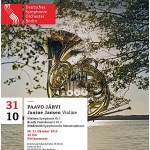By Rebecca Schmid
The Deutsches Symphonie-Orchester Berlin is off to a fine start this season, having gained Tugan Sokhiev as music director after an interim period senza maestro following Ingo Metzmacher’s departure in 2010. On Wednesday, Paavo Järvi and the violinist Janine Jansen joined the orchestra together for the first time in a performance of Bruch’s Violin Concerto at the Philharmonie. The only work by this German composer to have entered the canon is also his first violin concerto, an original assimilation of the devotion to Mendelssohn and Schumann which he would never relinquish despite the growing influence of the New German School in his time.
Jansen, a regular fixture in the Philharmonie-based chamber series Spectrum Concerts before entering the international spotlight, imbued improvisatory moments of lyricism in the opening movement with unselfconscious passion. While the climbing runs of the inner Adagio verged on the muscular, her seamless, chamber-like communication with the orchestra and its full-bodied strings, in much better form than last season, made for a satiating performance. The account grew in intensity for the last movement as Jansen’s visceral playing found an ideal outlet in Bruch’s fierce harmonics. Her liveliness carried directly over to the orchestra in fortissimo passages which Järvi harnessed without force. As an encore, Jansen offered a soulful account of a Bach Partita, finding the right balance between introspection and sentimentality.
The opening performance of Nielsen’s First Symphony, which leans heavily on Beethoven for structural and motivic inspiration, proved less gripping. While the tension brewing in the simple harmonies of the inner Andante emerged nicely through the DSO’s chiselled strings, the climatic harmonic changes of the third movement could have been plumbed to greater effect. The orchestra also did not shine in hard-edged attacks and at times wobbly woodwinds of the first Allegro movement. Järvi’s good humored presence kept the energy high through moments of Nordic grandeur, and the orchestra found its stride in the winding melodies of the final movement.
Closing the evening was Hindemith’s Symphonic Metamorphoses on Themes by Carl Maria von Weber, a dance commission premiered by the New York Philharmonic in 1944 and choreographed for City Ballet under Balanchine eight years later. The modernist setting of Romantic melodies found inspiration in Stravinsky’s neo-classical Pulcinella, which makes itself especially apparent in the cheeky low woodwinds of the second Turandot movement. The DSO’s direct, spirited playing served the music well in its stern but free polyphonic invention, culminating in a sardonic march.
The Knights’ latest Release…
The clichéd notion of Beethoven an uplifting force for humanity seems a strange fit for the Knights, an orchestra of young freelancers whose flexible format and dramaturgically innovative programming provide a promising alternative in today’s climate of stalled bureaucratic dealings and gloomy discussions about attracting new audiences. The ensemble’s most recent independent album, A Second of Silence, released earlier this year on Ancalagon LLC, interweaves Satie, Glass, Feldman and Schubert. Meanwhile, the Knights also teamed up with cellist and Dresden Music Festival Intendant Jan Vogler for an all-Beethoven “prelude to the 2012/13 season,” out on Sony Classical since September 28. The orchestra, which has mostly stayed close to U.S. territory, has collaborated with Vogler on several occasions since winning his attention four years ago—performing a Beethoven symphony. “I was struck immediately by the fresh and innovative interpretation, but also by the musicians’ treatment of each other, by the ideals of a true communality which hold this orchestra together,” he writes in liner notes.
The album takes what the press release describes as “two contrastive compositions,” the Triple Concerto and the Fifth Symphony. Both were written within the same four-year period, published respectively in 1807 and 1809—the year Napoleon proclaimed himself emperor—but, as concert master and Knights co-founder Colin Jacobsen points out, show the composer in two very different moods. Beethoven’s Fifth may be one of the most hackneyed symphonic works today, having emerged alongside the Ninth as musical specimens able to redeem mankind from the horrors of world war, yet it is easy to understand Vogler’s coup de foudre. Eric Jacobsen leads the orchestra with a lightness that evokes an embrace of life as much as a struggle of man against fate. By contrast, even Leonard Bernstein and the New York Philharmonic, documented on Sony Classical Great Performances, seem weighed down by the forces of history.
The Knights’ unusually fleet articulation of the iconic four-note motive in the opening movement and evasion of bombast in the final Allegro propel the music away from ruminations about tortured genius and into a realm in which the joy of music-making triumphs, even if it at times skims over the surface of “the tremendous inner battle” Bernstein saw in this manuscript. The orchestra nevertheless captures an introspective quality, such as in the dance-like inner Andante, breathing together like a chamber ensemble, and infusing the piece with renewed vitality. The Triple Concerto, featuring solo parts for violin, cello and piano, similarly sheds a cloak of nostalgia for restraint and buoyancy, creating exciting suspense in what Jacobsen rightly identifies as an “operatic sense of drama” in the opening bars and moving through French-inspired rhythms with grace. The violinist’s solos are sweet and unassuming in the inner Largo, never too majestic, echoed sensitively by pianist Antti Siirala and Vogler’s lamenting cello. The recording gives a balanced account of the instruments’ interactions, a further argument in favour of adding yet another Beethoven album to the shelf.
